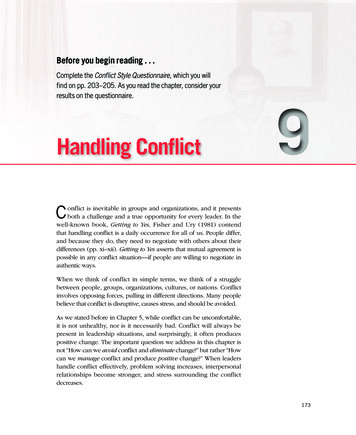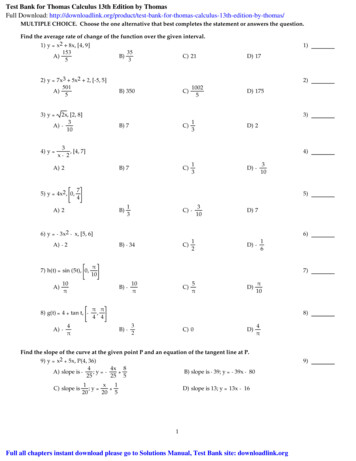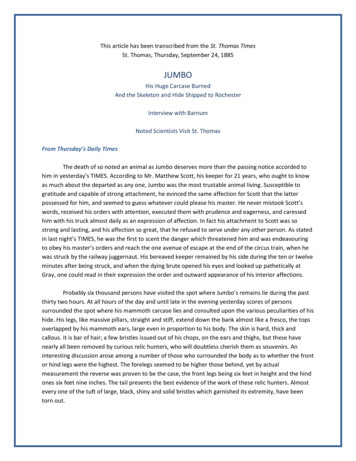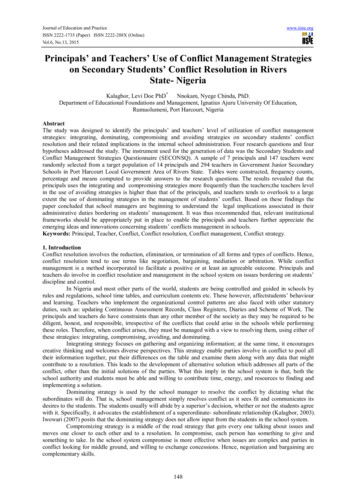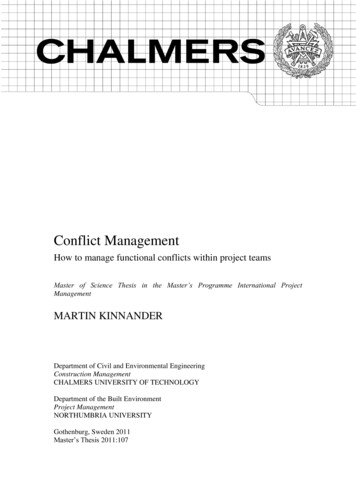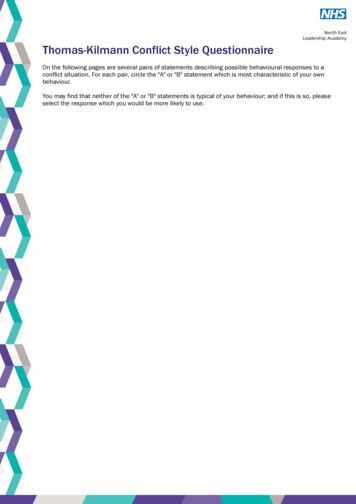
Transcription
Thomas-Kilmann Conflict Style QuestionnaireOn the following pages are several pairs of statements describing possible behavioural responses to aconflict situation. For each pair, circle the "A" or "B" statement which is most characteristic of your ownbehaviour.You may find that neither of the "A" or "B" statements is typical of your behaviour; and if this is so, pleaseselect the response which you would be more likely to use.
1 A. There are times when I let others take responsibility for solving the problem.B. Rather than negotiate the things on which we disagree, I try to stress those things uponwhich we both agree.2 A. I try to find a compromise solution.B. I attempt to deal with all of his/her and my concerns.3 A. I am usually firm in pursuing my goals.B. I might try to soothe the other's feelings and preserve our relationship.4 A. I try to find a compromise solution.B. I sometimes sacrifice my own wishes for the wishes of the other person.5 A. I consistently seek the other's help in working out a solution.B. I try to do what is necessary to avoid useless tensions.6 A. I try to avoid creating unpleasantness for myself.B. I try to win my position.7 A. I try to postpone the issue until I have had some time to think it over.B. I give up some points in exchange for others.8 A. I am usually firm in pursuing my goals.B. I attempt to get all concerns and issues immediately out in the open.9 A. I feel that differences are not always worth worrying about.B. I make some effort to get my way.10 A. I am firm in pursuing my goals.B. I try to find a compromise solution.11 A. I attempt to get all concerns and issues immediately out in the open.B. I might try to soothe the other's feelings and preserve our relationship.12 A. I sometimes avoid taking positions which would create controversy.B. I will let the other person have some of his/her positions if he/she lets me have some ofmine.13 A. I propose a middle ground.B. I press to get my points made.14 A. I tell the other person my ideas and ask for his/hers.B. I try to show the other person the logic and benefits of my position.15 A. I might try to soothe the other's feelings and preserve our relationship.B. I try to do what is necessary to avoid tensions.16 A. I try not to hurt the other's feelings.B. I try to convince the other person of the merits of my position.17 A. I am usually firm in pursuing my goals.B. I try to do what is necessary to avoid useless tensions.18 A. If it makes other people happy, I might let them maintain their views.B. I will let other people have some of their positions if they let me have some of mine.
19 A. I attempt to get all concerns and issues immediately out in the open.B. I try to postpone the issue until I have had some time to think it over.20 A. I attempt to immediately work through our differences.B. I try to find a fair combination of gains and losses for both of us.21 A. In negotiations, I try to be considerate of the other person's wishes.B. I always lean toward a direct discussion of the problem.22 A. I try to find a position that is intermediate between his/hers and mine.B. I assert my wishes.23 A. I am very often concerned with satisfying all our wishes.B. There are times when I let others take responsibility for solving the problem.24 A. I try meet to meet the wishes of others when it’s important to them.B. I try to get the other person to settle for a compromise.25 A. I try to show the other person the logic and benefits of my position.B. In negotiations, I try to be considerate of the other person's wishes.26 A. I propose a middle ground.B. I am nearly always concerned with satisfying all our wishes.27 A. I sometimes avoid taking positions that would create controversy.B. If it makes other people happy, I might let them maintain their views.28 A. I am usually firm in pursuing my goals.B. I usually seek the other's help in working out a solution.29 A. I propose a middle ground.B. I feel that differences are not always worth worrying about.30 A. I try not to hurt the other's feelings.B. I always share a problem with the other person so that we can work it out.
Scoring Your Thomas-Kilmann ResponsesCircle the letters below which you circled on each item of the questionnaire and total the numbers in mmodatingBBBAABBAvoidingABABBA
Thomas-Kilmann Conflict Style BackgroundRef: From Thomas-Kilmann – Conflict Mode InstrumentThe questionnaire is designed to assess your behaviour in conflict situations, where a situation arisesand at least two people appear to be incompatible. In such situations, we can describe a person'sbehaviour along two basic dimensions: (1) Assertiveness, the extent to which the individual attempts tosatisfy his/her own concerns, and (2) Cooperativeness, the extent to which the individual attempts tosatisfy the other person's concerns. These two basic dimensions of behaviour can be used to define fivespecific methods of dealing with conflicts, as shown on the grid below:You will have a numerical score for each of the five conflict mode styles, competing, avoiding,accommodating, collaborating and compromising. Your highest scoring column represents the conflictstyle mode that is your ‘default or natural’ mode.Each of the five columns has a range of possible scores from 0 (for very low use) to 12 (for very high use).These have been averaged out on a distribution curve against other manager responses. Check yourrange of scores against the following key to identify how they compare in relation to other managers inyour business idingAccommodatingHigh8 to 129 to 129 to 128 to 127 to 12Average4 to 76 to 85 to 85 to 73 to 6Low0 to 30 to 50 to 40 to 40 to 2
Five Conflict Mode DescriptionsRead the descriptions below for each of the five different conflict modes taking particular note of yourhighest conflict style.COMPETING - Is assertive and uncooperative - an individual pursues their own concerns at the otherperson's expense. This is a power-oriented mode, in which one uses whatever power seems appropriateto win one's own position - one's ability to argue, one's rank, economic sanctions. Competing might mean"standing up for your rights," defending a position which you believe is correct, or simply trying to win.ACCOMMODATING - Is unassertive and cooperative - the opposite of competing. When accommodating,an individual neglects their own concerns to satisfy the concerns of the other person; there is an elementof self-sacrifice in this mode. Accommodating might take the form of selfless generosity or charity,obeying another person's order when one would prefer not to, or yielding to another's point of view.AVOIDING - Is unassertive and uncooperative - the individual does not immediately pursue their ownconcerns of those of the other person. They do not address the conflict. Avoiding might take the form ofdiplomatically side-stepping an issue, postponing an issue until a better time, or simply withdrawing froma threatening situation.COLLABORATING - Is both assertive and cooperative - the opposite of avoiding. Collaborating involves anattempt to work with the other person to find some solution which fully satisfies the concerns of bothpersons. It means digging into an issue to identify the underlying concerns of the two individuals and tofind an alternative which meets both sets of concerns. Collaborating between two persons might take theform of exploring a disagreement to learn from each other's insights, concluding to resolve somecondition which would otherwise have them competing for resources, or confronting and trying to find acreative solution to an interpersonal problem.COMPROMISING - Is intermediate in both assertiveness and cooperativeness. The objective is to findsome expedient, mutually acceptable solution which partially satisfies both parties. It falls on a middleground between competing and accommodating. Compromising gives up more than competing but lessthan accommodating. Likewise, it addresses an issue more directly than avoiding, but does not explore itin as much depth as collaborating. Compromising might mean splitting the difference, exchangingconcessions, or seeking a quick middle-ground position.
Appropriate Use of Conflict ModesEach of the five conflict modes has its strengths and weaknesses, depending upon the conflict situationyou are in. To maximise your ability to influence and manage conflict it is important to know how to adaptyour style according to the situation you find yourself in.The following chart depicts some examples of conflict situations, and suggests the most appropriateconflict mode to use for that situation.ActionThink about the conflict situations you have experienced at work, and how you handled them. Whatworked well for you and what might you need to change or develop?www.nelacademy.nhs.uk0191 371 3634 nelacademy@nelacademy.nhs.ukTwitter: @Nelacademy Facebook: nelacademy
Thomas-Kilmann Conflict Style Questionnaire On the following pages are several pairs of statements describing possible behavioural responses to a conflict situation. For each pair, circle the "A" or "B" statement which is most characteristic of your own behaviour. You may find that neither of the "A" or "B" statements is typical of your behaviour; and if this is so, please select the response .

